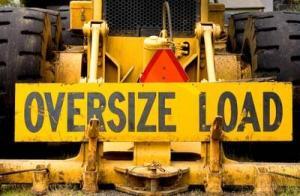When it comes to hauling freight across the United States one of the most popular trailers seen on the road is the flatbed trailer. This trailer is extremely versatile in its abilities to hauling obscure, oversized, and difficult to load and unload shipments with ease. What makes a flatbed trailer so great for loading and unloading? Essentially a flatbed trailer is a long flat deck trailer; it has no sides, no back, and no roof so it is completely open. This allows many different options available to load unload the trailer, the trailer can still be backed up a loading dock for freight to be loaded from the rear, but one of the most common tools used for freight is the forklift. The forklift has the ability to load and unload freight from the either side of the trailer or the rear of trailer. The use of the forklift is very efficient as it can move freight up and off the deck of the trailer and position the freight as it goes, all while saving time. Another way large or obscure freight can be loaded onto these trailers is through the use of a crane, the crane has the ability to load the freight directly on top of the trailer and then secured down for transportation.
 Flatbed trailers are used to haul anything from building materials, palletized freight loads, and large machinery and equipment, but there are rules and regulations that limit the size of what the flatbed trailer can haul across the United States, these load size rules and restrictions are regulated by laws federally and at the state level. Some states may have some slight differences when it comes to maximum allowable length, width, or height, so it is always best to know what each states regulations are and what highways or interstate systems your freight will be traveling through to make sure the freight load is meeting all legal requirements. Typical load restrictions are as follows:
Flatbed trailers are used to haul anything from building materials, palletized freight loads, and large machinery and equipment, but there are rules and regulations that limit the size of what the flatbed trailer can haul across the United States, these load size rules and restrictions are regulated by laws federally and at the state level. Some states may have some slight differences when it comes to maximum allowable length, width, or height, so it is always best to know what each states regulations are and what highways or interstate systems your freight will be traveling through to make sure the freight load is meeting all legal requirements. Typical load restrictions are as follows:
Maximum Load Width – 8’6″
Maximum Load Height (includes total height of trailer & freight)– 13’6″
Maximum Load Length – Depends on the trailer length, the maximum length for the load on a trailer is typically the length of the trailer, but in certain situations loads can hang up to 4′ off of a 48′ trailer where no overhang is allowed on a 53′ trailer.
Most loads being transported today are referred to as legal loads, that’s because they meet all the proper height, weight, and width restrictions required to be transported nationally and at the state level. What happens if your load exceeds any of these restrictions? Permits can be purchased to accommodate for loads that exceed the legal limits for transportation, so depending on what needs to be transported, the maximum restrictions for height, weight and width can be exceeded as long as the proper permits are purchased. Sometimes these permits will come with added restrictions for travel, this can ensure the safety for motorists and the load being transported itself, some of these limitations can include, time and date of travel, route designations and restrictions, marking requirements and also the possibility of pilot cars. Lastly if the load is able to be split between 2 truck and trailer combinations in order to meet the legal load limits, then no permit can be granted. While this may seem like a lot of rules to keep track of, the team at Freight Rate Central. is experts at coordinating every last step of the shipping process to ensure your load is meeting all the legal requirements while offering you the best customer service and pricing! Stop by our website today for a free instant online freight quote!








